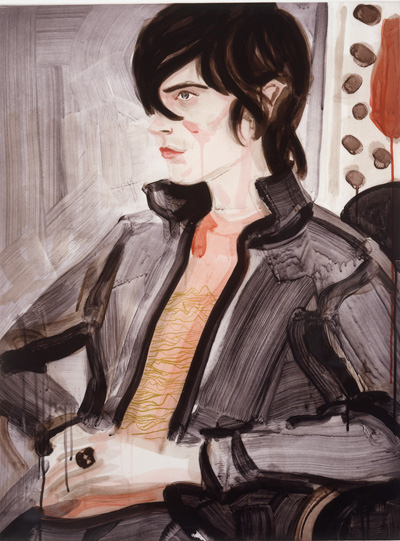
Elizabeth Peyton, "Nick," 2004. Seven-color etching with aquatint, 31 ¾ x 24 inches, Edition of 40. Collection of RBC Wealth Management. Image courtesy of the artist and Gavin Brown’s enterprise © Elizabeth Peyton.
Quick-to-See Smith, a member of the Flathead Indian Nation in Montana, creates artwork that addresses the myths, values, and experiences of her Native American ancestors in the context of contemporary issues. Influenced by Jackson Pollock and Jasper Johns, she works with appropriated images to confront such subjects as the destruction of the environment and the oppression of native cultures.
Born in China during the Communists’ rise to power, Hung Liu received her art training in the realist style promoted by the government. In 1984, she was allowed to leave the country to pursue a degree in California. Although she remained there, she explores Chinese history and culture in her paintings by reworking old Chinese photographs. “The drips of paint that cover her canvases have important symbolic intent,” Stamey explains. “They refer art historically to Chinese ink painting and American Abstract Expressionism, and metaphorically to veiled memories and tears.”
Michael Vasquez grew up as the only child of a single mother in St. Petersburg, Fla., and found father figures through associations with the Young Bloods street gang. In his portraits of gang members, he acknowledges the potential for gangs to provide friendship, family and a sense of order in a world that often feels dysfunctional and disorienting. “While his subjects are always presented as proud, rather than menacing, Vasquez’s aggressive brushwork suggests the intensity of their lives on the street,” Stamey says.
And, in her photographs, Israeli artist Tiranit Barzilay Cohen stages people in empty rooms and corridors. Shown in various states of undress, these figures convey feelings of vulnerability, uncertainty, solitude and a loss of identity. Says Stamey: “In many of her images, associations with the Holocaust are also brought to mind as her subjects stand in line, appearing to wait anxiously and submissively for an unknown fate.”
Brown is an African-American artist working in Washington, DC. In her paintings and prints, she uses images of geisha and samurai taken from centuries-old Japanese woodblock prints and makes them over in contemporary style.
